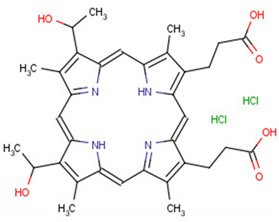
Hematoporphyrin dihydrochloride
CAS No. 17696-69-4
Hematoporphyrin dihydrochloride( Hematoporphyrin IX dihydrochloride )
Catalog No. M18132 CAS No. 17696-69-4
Hematoporphyrin dihydrochloride is a substrate for affinity chromatography of heme-binding proteins.
Purity : >98% (HPLC)
 COA
COA
 Datasheet
Datasheet
 HNMR
HNMR
 HPLC
HPLC
 MSDS
MSDS
 Handing Instructions
Handing Instructions
| Size | Price / USD | Stock | Quantity |
| 50MG | 49 | Get Quote |


|
| 100MG | Get Quote | Get Quote |


|
| 200MG | Get Quote | Get Quote |


|
| 500MG | Get Quote | Get Quote |


|
| 1G | Get Quote | Get Quote |


|
Biological Information
-
Product NameHematoporphyrin dihydrochloride
-
NoteResearch use only, not for human use.
-
Brief DescriptionHematoporphyrin dihydrochloride is a substrate for affinity chromatography of heme-binding proteins.
-
DescriptionHematoporphyrin dihydrochloride is a substrate for affinity chromatography of heme-binding proteins.
-
In VitroCell Viability Assay Cell Line:U87 and U251 cells Concentration:20, 40, 60, 80, 100, 120 nM Incubation Time:60 min Result:Inhibited cell viability in a dose-dependent manner.Was more effective under the red light than white light.Apoptosis Analysis Cell Line:U87 cells Concentration:85 nM Incubation Time:60 min Result:Induced apoptotic nuclei in U87 cells with low cell density.Induced the ROS and decreased the mitochondrial membrane potential.
-
In VivoAnimal Model:Wistar albino rats of both sexes (20 d; 60-80 g) bearing a subcutaneous solid Yoshida hepatoma AH-130Dosage:5, 10 mg/kg Administration:I.p. daily during the initial 10 days and biweekly for the next 2 months Result:No tumor could be palpated a few days after exposure of the rats to light.The skin healed completely and regrowth of the hair occurred.Massive coagulation necrosis of the tumor 24 h after photo treatment (×40).
-
SynonymsHematoporphyrin IX dihydrochloride
-
PathwayChromatin/Epigenetic
-
TargetEpigenetic Reader Domain
-
RecptorOthers
-
Research AreaOthers-Field
-
Indication——
Chemical Information
-
CAS Number17696-69-4
-
Formula Weight671.61
-
Molecular FormulaC34H40Cl2N4O6
-
Purity>98% (HPLC)
-
SolubilityDMSO : ≥ 50 mg/mL 74.45 mM; H2O : < 0.1 mg/mL
-
SMILESCl.C\1=c/2\[nH]/c(=C\C3=N/C(=C\c4[nH]c(c(c4C)CCC(=O)O)/C=C/4\N=C1C(=C4CCC(=O)O)C)/C(=C3C)C(C)O)/c(c2C)C(C)O.Cl
-
Chemical Name——
Shipping & Storage Information
-
Storage(-20℃)
-
ShippingWith Ice Pack
-
Stability≥ 2 years
Reference
1.Olsen, K.W.Methods Enzymol, 1986. 123: p. 324-31.
molnova catalog



related products
-
PBRM1-BD2-IN-7
PBRM1-BD2-IN-7, a selective and cell-active inhibitor targeting the polybromo-1 (PBRM1) bromodomain, demonstrates inhibitory efficacy against PBRM1-BD2 with an IC50 value of 0.29 μM.
-
Molibresib besylate
Molibresib besylate (GSK 525762C) is a selective and potent inhibitor of the bromodomain and extra-terminal (BET) family of proteins with potential anticancer activity for the study of refractory hematologic malignant diseases.
-
ZEN-3219
ZEN-3219 is a BET inhibitor, which has inhibitory effect on BRD4(BD1), BRD4(BD2) and BRD4(BD1BD2).



 Cart
Cart
 sales@molnova.com
sales@molnova.com


